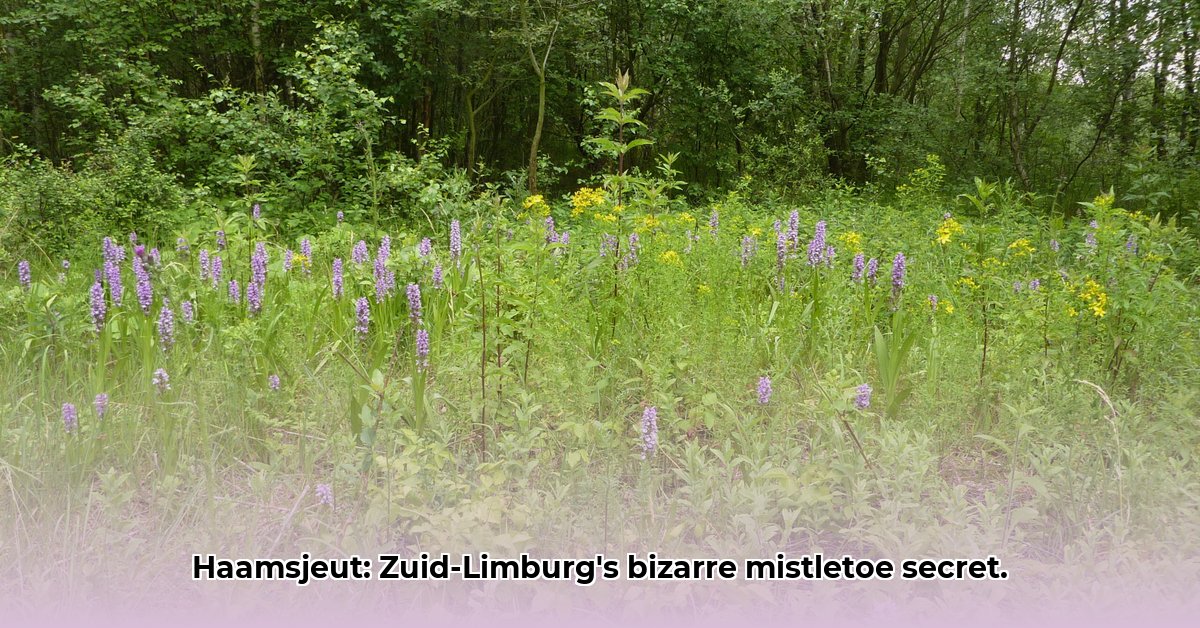
Imagine a winter's day in Zuid-Limburg, the trees stark against a grey sky. Suddenly, a vibrant splash of green catches your eye: Viscum album, the common mistletoe, but here, it's known by a far more evocative name – haamsjeut. This isn't just a plant; it's a botanical and linguistic enigma, shrouded in local lore. This article unravels the mystery behind haamsjeut, exploring its intriguing etymology, the plant's unique biology, and its place within Zuid-Limburg's cultural tapestry. We'll also discover how its name contrasts sharply with the often-used "duivelsnest" (devil's nest), revealing layers of both fascination and fear.
The Botanical Enigma: Viscum album
Let's start with the plant itself. Viscum album, a hemiparasite (a plant that partially relies on a host for survival), isn't merely a passive observer. It's a tenacious survivor, anchoring itself to branches of its host tree, drawing water and minerals while cleverly generating its own food through photosynthesis. Its pearly white berries, a striking contrast against the bare winter branches, have likely captivated the imaginations of Zuid-Limburg residents for centuries. These berries, some suggest, might even hold a clue to the origin of the name "haamsjeut." Could their appearance have inspired the name? Further botanical research is needed to investigate this possibility.
Deciphering "Haamsjeut": A Linguistic Puzzle
The name "haamsjeut" itself is a linguistic puzzle – a true head-scratcher. Some suggest a connection to “haam,” the Limburgish word for a horse's bridle, likening the spreading branches of the mistletoe to the reins. It's a captivating visual, yet remains just one theory. Another common nickname, "duivelsnest" (devil's nest), presents a starkly contrasting image, hinting at a potential connection to superstition or folklore. Did the parasitic nature of the plant, taking sustenance from its host, lead to its association with something malevolent?
Professor Piet Beurskens, emeritus professor of linguistics at Maastricht University, suggests, "The etymology of 'haamsjeut' remains highly debated. Further research into historical Limburgish dialects and early written sources is crucial to definitively trace its origin." This highlights the need for meticulous linguistic investigation, examining regional variations and historical records to uncover the true meaning behind this fascinating name.
Cultural Threads: Traditions and Beliefs
Does "haamsjeut" hold any special place in Zuid-Limburg's cultural traditions? While concrete evidence remains scarce, the enduring use of the name itself suggests a deep-rooted connection. The lack of readily available documentation highlights the importance of gathering oral histories and investigating local folklore. Did "haamsjeut" play a role in local customs or beliefs? Were there any rituals or stories associated with the plant that could help unlock the secrets behind its name? This area is ripe for further investigation.
Where Does Haamsjeut Thrive? A Botanical Quest
The distribution of Viscum album within Zuid-Limburg isn't uniform. Some believe it thrives in areas with rich, lime-rich soil ("kalkrijke grond"). But is this a definitive link? Does the soil composition really influence its growth preference? Or are there other factors at play? Further research is needed, involving detailed mapping of the plant's distribution alongside a thorough analysis of soil types and tree species. This could reveal important insights into both the plant's ecology and potentially the health of the host trees. A healthy, thriving haamsjeut may well indicate a healthy tree itself, which could have implications for conservation efforts.
Ongoing Research: Unraveling the Mystery
The mystery surrounding "haamsjeut" provides a unique opportunity for interdisciplinary research. A combined effort of linguists, botanists, and anthropologists is needed. Linguists can delve deeper into local dialects, botanists can map the plant's distribution and study its ecological interactions, and anthropologists can examine local traditions and folklore. By weaving together these threads, we can create a fuller picture—a holistic understanding of the plant and its cultural significance.
Conclusion: A Tale of Two Mysteries
The mystery of "haamsjeut" is more than just a linguistic exercise; it’s a window into the rich cultural heritage of Zuid-Limburg. It highlights the fascinating interplay between language, botany, and folklore. While we may not yet have all the answers, the journey of discovery itself is incredibly rewarding. Unraveling the mystery of haamsjeut encourages us to appreciate both the biodiversity and linguistic heritage that enrich our world. The investigation continues, promising further revelations about this enigmatic plant and the stories it holds within its name.